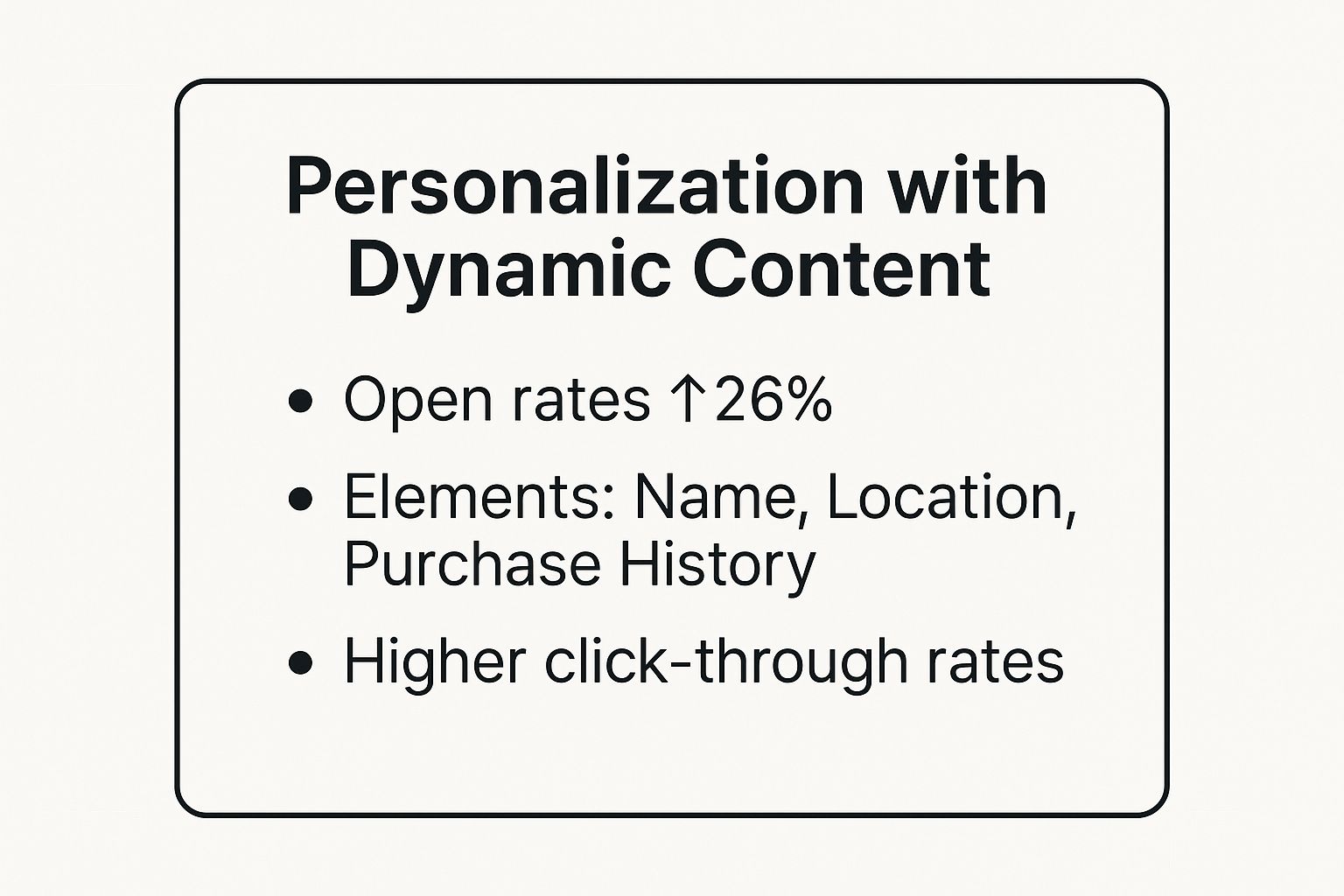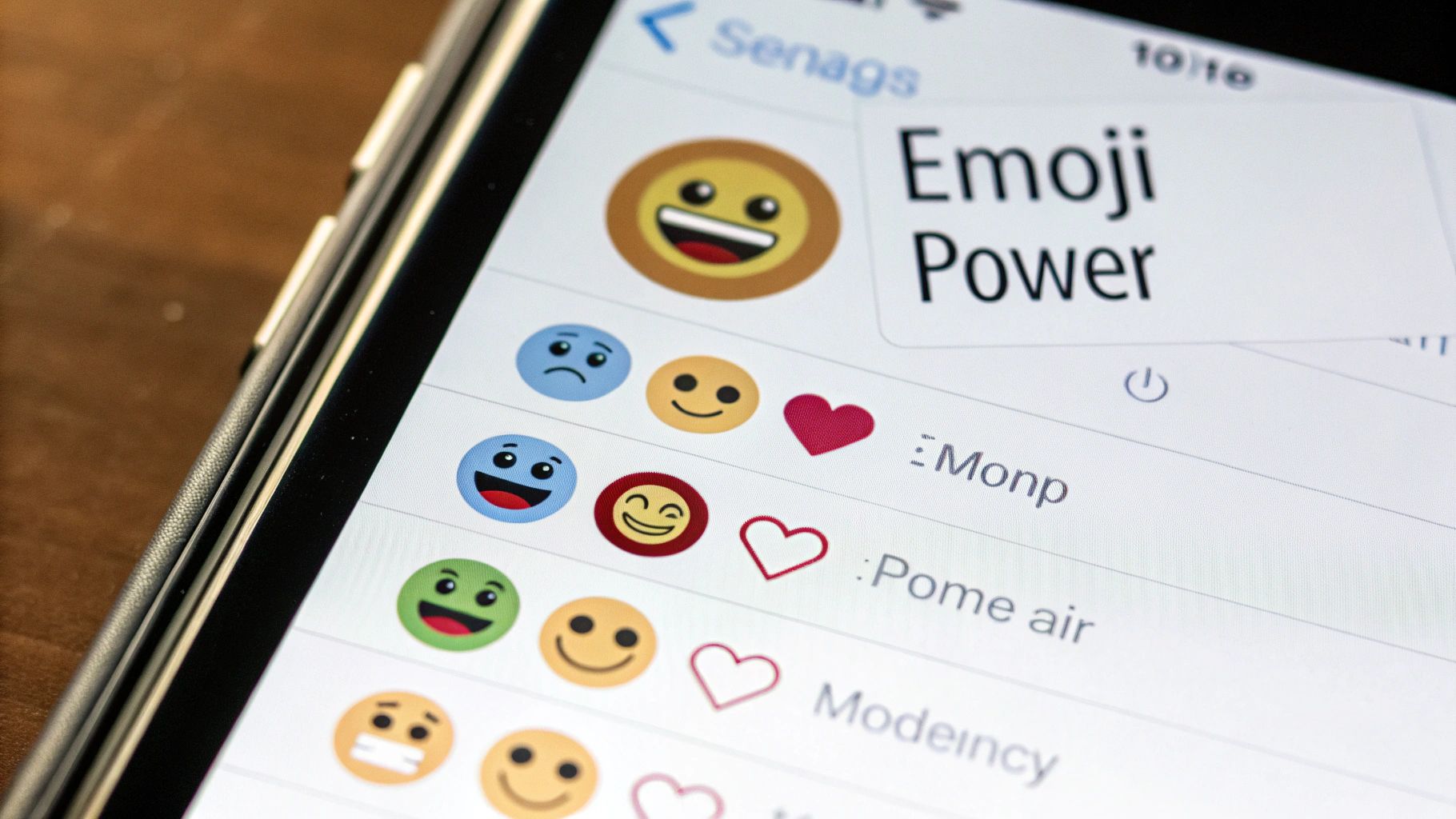The humble subject line is often the single most important factor determining whether your email gets opened or ignored. It’s the first impression, the digital handshake, and the gatekeeper to the valuable message inside. In a crowded inbox, a generic or uninspired subject line is a guaranteed path to the trash folder. This is why having a collection of effective email subject line examples is not just helpful, it’s essential for modern sales and marketing teams.
This guide goes beyond a simple list of templates. We will dissect why certain subject lines work, breaking down the specific strategies and psychological triggers they use. You won’t just get examples to copy and paste; you’ll learn the underlying principles to craft your own high-performing subject lines for any situation.
We will explore tactics like creating urgency without sounding desperate, sparking curiosity, and delivering a clear value proposition in just a few words. From cold outreach and critical follow-ups to re-engagement campaigns and promotional announcements, each example is analyzed to give you actionable takeaways. You will learn how to replicate these successes, turning a daunting creative task into a predictable, strategic process. Let’s dive into the examples that will get your emails opened, read, and acted upon.
1. Personalization with Dynamic Content
Personalization is the secret ingredient that transforms a generic mass email into a direct, one-to-one conversation. This strategy involves using recipient data, such as their name, company, or past interactions, to create highly relevant and engaging email subject line examples. By making the recipient feel seen and understood, you immediately capture their attention in a crowded inbox.
Why It Works
The effectiveness of personalization is rooted in basic human psychology. We are wired to respond to our own name and to information that feels specifically tailored to us. Seeing a subject line like “John, an idea for [Company Name]” instantly signals that the email is not just another automated blast but a message intended specifically for John. This relevance dramatically increases the likelihood of an open.
- Grabs Attention: Using a name or a specific detail cuts through the noise.
- Builds Connection: It shows you’ve done your homework and value the recipient as an individual.
- Boosts Relevance: A personalized subject line promises content that is directly applicable to the recipient’s needs or interests.
Examples in Action
Let’s look at a few powerful email subject line examples that use this technique:
- “Sarah, we found the perfect shoes for you”: This leverages past browsing or purchase history to offer a tailored recommendation.
- “Your cart misses you, Michael”: A gentle, personalized nudge to complete a purchase.
- “Quick question about [Company Name]’s goals”: Shows you’re focused on their business, not just making a sale.
The key is to ensure the data you use is accurate. An email with the wrong name or company detail can do more harm than good. To maximize the effectiveness of this strategy, maintaining a clean and updated contact list is essential. You can learn more about keeping your data accurate with email list cleaning.
This summary box highlights the proven impact of incorporating dynamic content into your subject lines.

The data clearly shows that even simple personalization, like using a recipient’s name, can lead to a significant 26% increase in open rates and higher overall engagement.
2. Urgency and Scarcity Tactics
Urgency and scarcity are powerful psychological triggers that compel people to act quickly. This strategy involves creating a sense of limited time or availability in your subject lines to motivate immediate action. By leveraging concepts like FOMO (fear of missing out), you can encourage recipients to prioritize your email over others in their inbox, driving higher open and conversion rates.

Why It Works
The power of urgency is tied to the principle of loss aversion. People are more motivated by the fear of losing something than by the prospect of gaining something of equal value. When a subject line like “Last chance: Sale ends tonight at midnight” appears, it signals that inaction will lead to a missed opportunity. This prompts an immediate response to avoid potential regret.
- Drives Immediate Action: A clear deadline or limited quantity discourages procrastination.
- Increases Perceived Value: Scarcity makes an offer or product seem more exclusive and desirable.
- Stands Out in the Inbox: Urgent language creates a sense of importance that captures attention.
Examples in Action
Let’s look at some effective email subject line examples that use urgency and scarcity to their advantage:
- “24 hours left: 50% off everything”: This creates a specific, short timeframe that motivates an immediate click.
- “Only 3 seats remaining for tomorrow’s webinar”: Highlighting a limited quantity is perfect for events or exclusive offers.
- “Your trial is ending soon, [Name]”: This combines urgency with personalization to prompt a decision about upgrading.
To make this tactic effective, the urgency must be genuine. Overusing false deadlines can lead to subscriber fatigue and damage trust. To see how these tactics can improve your metrics, you can explore how to improve your click-to-open rate here.
The data highlights how incorporating urgency can significantly lift engagement, with some campaigns seeing a 22% increase in open rates.
3. Curiosity Gap Technique
The curiosity gap technique is a powerful psychological trigger that makes your subject line nearly impossible to ignore. This strategy works by revealing just enough information to pique interest while withholding a key detail, creating an “information gap” that the recipient feels compelled to close by opening the email.
Why It Works
This method leverages our innate desire for closure and answers. When presented with a puzzle or an incomplete story, our brains naturally seek to fill in the missing pieces. A subject line like “The one thing successful leaders never do” creates an immediate question in the recipient’s mind: “What is that one thing?” This mental itch is a strong motivator to click and find the answer.
- Sparks Intrigue: It creates a sense of mystery that stands out from typical, descriptive subject lines.
- Drives Clicks: The need to satisfy curiosity is a powerful driver for action, boosting open rates.
- Promises Value: It suggests that the email contains exclusive or surprising information.
Examples in Action
Let’s look at a few email subject line examples that effectively use the curiosity gap:
- “The mistake 90% of marketers make”: This creates urgency and positions the email as a source of critical, non-obvious information.
- “Why smart people are doing this one thing”: It combines social proof with curiosity, making the recipient want to join an exclusive group.
- “You won’t believe what our top clients are saying”: This builds anticipation for a surprising or highly positive revelation.
The key to this technique is to always deliver on the promise made in the subject line. If the content of your email doesn’t satisfy the curiosity you created, you risk frustrating your audience and damaging trust. Ensure the “reveal” is valuable and directly related to the recipient’s interests. This balance of intrigue and payoff is what makes the curiosity gap a winning strategy.
4. Direct Value Proposition
A Direct Value Proposition subject line gets straight to the point by clearly stating the benefit the recipient will gain from opening the email. This approach trades cleverness for clarity, prioritizing an immediate and compelling reason for the user to engage. It tells the recipient exactly what’s in it for them, making the decision to open quick and easy.
Why It Works
This method is effective because it respects the recipient’s time and answers the unspoken question, “What’s in it for me?” In a B2B context, where professionals are looking for solutions and results, a subject line like “Increase your sales by 30% with this strategy” immediately signals that the email contains valuable, actionable information. This transparency builds trust and sets clear expectations.
- Prioritizes Clarity: It eliminates guesswork and communicates the core benefit instantly.
- Highlights Tangible Outcomes: Using specific numbers and results makes the value proposition more credible.
- Filters for Interest: It attracts recipients who are genuinely interested in the promised value, leading to higher-quality opens.
Examples in Action
Let’s look at a few powerful email subject line examples that use a direct value proposition:
- “5 tools to automate your workflow”: This promises a specific number of solutions to a common business challenge, making it highly actionable.
- “Your complete guide to email marketing”: Offers comprehensive, educational value that positions the sender as an expert.
- “Free shipping on all orders this weekend”: A classic e-commerce example that presents a clear, time-sensitive financial benefit.
To succeed with this strategy, the promised value must be delivered immediately in the email body. A bait-and-switch will harm your credibility. The key is to lead with your strongest, most quantifiable benefit. You can find more templates that use this approach to craft effective messages in these cold outreach email templates.
5. Question-Based Engagement
Posing a question in your subject line is a powerful way to immediately engage the recipient’s mind. This technique shifts the dynamic from a passive announcement to an active conversation starter, prompting curiosity and encouraging the recipient to open the email to find the answer. It creates a mental itch that can only be scratched by clicking through.
Why It Works
This strategy leverages the psychological principle of curiosity. Humans are naturally inquisitive, and when presented with a direct question, our brains are wired to seek an answer. A subject line like “Are you making these common mistakes?” makes the recipient pause and reflect, immediately connecting them with the email’s potential content. This method is incredibly effective for creating instant relevance.
- Sparks Curiosity: An open-ended question creates a knowledge gap the recipient wants to fill.
- Encourages Interaction: It frames the email as a dialogue rather than a monologue.
- Highlights a Problem: Posing a question can subtly introduce a pain point that your product or service solves.
Examples in Action
Let’s explore a few email subject line examples that use questions to drive opens:
- “What’s stopping you from reaching your goals?”: This is ideal for coaching or consulting, tapping directly into the recipient’s aspirations and challenges.
- “Ready to double your productivity?”: A simple yes/no question that implies a clear, desirable benefit waiting inside.
- “How much could [Company Name] save this year?”: This targets B2B professionals by posing a question directly related to their business outcomes.
The most effective questions are those your audience is already asking themselves. By aligning your subject line with their internal monologue, you create a powerful connection that makes your email feel essential. This approach is excellent for nurturing potential leads. You can learn more about identifying engaged prospects with MQLs.
6. Social proof and Testimonial Integration
Social proof is a powerful psychological tool that leverages the actions and opinions of others to build trust and credibility. This strategy involves integrating customer testimonials, user statistics, or expert endorsements directly into your email subject line examples. By showing that others have already found value in your offering, you lower the recipient’s natural skepticism and create an immediate sense of validation.
Why It Works
The effectiveness of social proof is rooted in the idea that people are more likely to trust something if they see others, especially those they respect, are already using it. A subject line like “Join 50,000+ marketers who love our platform” immediately signals that your product is tested, proven, and popular. This reduces perceived risk for the recipient and makes them curious to learn why so many others are on board.
- Builds Instant Trust: It provides third-party validation before the email is even opened.
- Reduces Perceived Risk: Seeing that others have had success makes the decision to engage feel safer.
- Creates FOMO (Fear of Missing Out): High user counts or glowing reviews can make prospects feel they are missing out on a valuable tool.
Examples in Action
Let’s look at a few effective email subject line examples that use social proof to drive opens and engagement:
- “Rated #1 by industry experts for 3 years”: This leverages expert authority to establish credibility and leadership in the market.
- “See why 95% of our customers renew”: Highlighting a strong retention rate implies high customer satisfaction and long-term value.
- “‘This changed my business’ – Sarah, CEO”: Using a direct quote from a relatable figure, like a CEO, adds a personal and impactful touch.
To make this strategy work, the proof must be genuine and specific. Vague claims can seem untrustworthy, so always use real numbers, authentic quotes, and credible sources. Regularly updating your statistics ensures your social proof remains relevant and powerful.
7. Emoji and Visual Elements
Emojis and visual elements are the modern equivalent of a neon sign in a crowded inbox. This strategy involves strategically incorporating symbols like emojis to add personality, convey emotion, and make your email visually distinct. When used correctly, these visual cues can make your subject lines more expressive and scannable, drawing the eye and encouraging a click.
Why It Works
The power of emojis lies in their ability to communicate complex emotions and ideas instantly. In a text-heavy environment like an email inbox, a well-placed emoji provides a splash of color and character that immediately sets your message apart. It humanizes your brand and can often communicate a message’s tone more effectively than words alone, making your subject line feel more approachable and engaging.
- Increases Visibility: Emojis stand out visually, breaking up the monotony of text-only subject lines.
- Conveys Emotion: They add a layer of personality and tone, from playful to urgent.
- Saves Space: A single emoji can replace a word, keeping your subject line concise.
Examples in Action
Let’s explore some email subject line examples that effectively use visual elements to boost engagement:
- “🚀 Launch week: 50% off everything”: The rocket emoji creates a sense of excitement and urgency, perfectly complementing the launch announcement.
- “☕ Monday motivation inside”: This subject line uses a relatable emoji to build a friendly, casual connection with the reader.
- “🎉 You’re invited to our exclusive event”: The party popper emoji instantly communicates a celebratory and exclusive feeling, making the invitation more appealing.
The key to success is relevance and moderation. An emoji should enhance your message, not distract from it. Always consider your audience and brand voice; a playful emoji might work for a B2C fashion brand but could seem out of place in a formal B2B financial context. Limiting yourself to one or two relevant emojis is a best practice to avoid looking like spam.
8. Curiosity and Intrigue
Creating a sense of curiosity is a powerful psychological trigger that compels people to seek out missing information. This strategy involves writing email subject line examples that are intentionally vague or pose an intriguing question, making the recipient feel an irresistible urge to open the email to satisfy their curiosity and find the answer.

By leaving a gap in their knowledge, you create a mild tension that can only be resolved by clicking “open.” It’s a classic technique used in storytelling and advertising that works exceptionally well in a crowded inbox where standing out is critical.
Why It Works
Curiosity-driven subject lines tap into the human brain’s desire for closure and completeness, a concept known as the Zeigarnik effect. When we encounter a piece of incomplete information, our minds naturally want to fill in the blanks. This creates a compelling reason to engage with the email beyond just the perceived value of its content.
- Sparks Engagement: An intriguing question or statement is more engaging than a simple announcement.
- Breaks Patterns: It stands out from the typical, descriptive subject lines that fill most inboxes.
- Promises a Discovery: It hints that valuable or surprising information is waiting inside.
Examples in Action
Let’s explore a few effective email subject line examples that leverage the power of curiosity:
- “Don’t open this email”: This classic example of reverse psychology immediately piques interest and challenges the recipient to do exactly what they’re told not to.
- “Is this the future of [Industry]?”: Posing a forward-thinking question makes the recipient want to know the answer and see if they agree.
- “We need to talk about…”: This subject line creates a sense of urgency and importance, suggesting a private or significant conversation is about to happen.
The key to this strategy is ensuring the email’s body delivers on the promise created by the subject line. If the content is a letdown, you risk losing the recipient’s trust. The reveal should be satisfying and relevant to the intrigue you’ve built.
Email Subject Line Strategy Comparison
| Technique | Implementation Complexity | Resource Requirements | Expected Outcomes | Ideal Use Cases | Key Advantages |
|---|---|---|---|---|---|
| Personalization with Dynamic Content | High: Requires robust data and technical setup | Customer data management, privacy compliance | Increased open rates (+26%), higher engagement | Targeted marketing, retention campaigns | Creates individualized experience, boosts engagement |
| Urgency and Scarcity Tactics | Medium: Needs timely updates and varied messaging | Time-sensitive content creation | Significant open rate increase, faster decisions | Promotions, limited-time offers | Motivates immediate action, drives urgency |
| Curiosity Gap Technique | Medium: Crafting intriguing but relevant content | Creative copywriting | High open rates, memorable brand interactions | Content marketing, storytelling emails | Sparks curiosity, encourages engagement |
| Direct Value Proposition | Low: Clear, straightforward messaging | Clear value communication | Higher conversion, sets expectations | B2B, product announcements, educational | Builds trust, appeals to busy professionals |
| Question-Based Engagement | Low-Medium: Must align questions with audience | Audience insight, conversational tone | Creates mental engagement, active thinking | Surveys, feedback, consulting | Encourages interaction, fosters conversation |
| Social Proof and Testimonial Integration | Medium: Requires genuine testimonials and data | Collection of testimonials, statistics | Builds credibility and trust | SaaS, service businesses, consumer reviews | Leverages peer influence, reduces skepticism |
| Emoji and Visual Elements | Low: Simple to add but needs audience consideration | Design and cultural research | Can improve open rates up to 45% | Lifestyle, entertainment, mobile-first | Enhances visual appeal, conveys emotion quickly |
Putting It All Together: Your Subject Line Toolkit
We’ve explored a wide range of high-impact email subject line examples, moving from the strategic use of personalization to the tactical deployment of urgency and curiosity. While each example offers a unique approach, they all share a common foundation: a deep understanding of the recipient’s needs, motivations, and pain points. Your subject line is not just a title; it is the first handshake, the initial pitch, and the critical first impression all rolled into one powerful phrase.
Mastering this skill transforms your email outreach from a numbers game into a strategic communication channel. It’s the difference between a campaign that gets deleted and one that gets opened, read, and acted upon. The examples and strategies discussed in this guide provide the framework, but true success comes from adapting these principles to your specific audience and goals.
Key Takeaways for Immediate Action
To help you translate these ideas into results, let’s distill the core principles into a simple, actionable checklist. Think of this as your pre-flight check before hitting “send.”
- Prioritize Clarity Over Cleverness: A clever pun is useless if the recipient doesn’t understand the value inside. Always ensure your core message is clear and direct.
- Personalize Beyond the First Name: Use industry-specific data, reference a recent company event, or mention a shared connection. This level of detail shows you’ve done your homework.
- Create Value Before Asking for It: Your subject line should promise a benefit, a solution, or a piece of valuable information. Lead with what’s in it for them.
- Urgency Must Be Authentic: Use deadlines and scarcity only when they are genuine. Fabricated urgency erodes trust and diminishes the impact of future campaigns.
Your Next Steps: From Theory to Practice
Knowledge without action is just information. To truly benefit from these email subject line examples, you need to put them to the test. Here’s a simple plan to get started today:
- Segment Your List: Choose one specific audience segment for your next campaign. This could be new leads, inactive subscribers, or high-value prospects.
- Select Two Strategies: Pick two different subject line strategies from this article that you believe will resonate with that segment. For example, try a “Direct Value Proposition” against a “Curiosity Gap” approach.
- Run an A/B Test: Create two versions of your email with the only difference being the subject line. Send each version to a portion of your chosen segment.
- Analyze and Iterate: Review the open rates after a set period. Which subject line performed better? Why do you think that is? Use that insight to inform your next campaign, and then test again.
This continuous cycle of testing, learning, and iterating is the secret to developing an instinct for what works. The subject lines you write in six months will be exponentially more effective than the ones you write today. By embracing this process, you are not just sending emails; you are building a powerful engine for engagement, conversation, and growth. Now, go craft that perfect subject line and start seeing the results.

